15 March 2017
The Regional Economic Development Program III (RED III) is a Cambodian rural development program funded by Germany (BMZ) and Switzerland (SDC) and implemented with technical assistance by Gesellschaft für Internationale Zusammenarbeit (GIZ). The third phase of the program is scheduled to last from September 2014 to December 2017. It succeeds the GIZ-supported Regional Economic Development Program – Green Belt that was implemented in the province of Siem Reap from October 2007 until August 2014.
The program aims to support the poor, rural population – especially women – in using new, sustainable business and employment opportunities to increase their income and reduce poverty. Since January 2015, RED III is active in three provinces: Siem Reap, Banteay Meanchey and Oddar Meanchey. The program promotes four fields of activities (components) (1) Local government action for inclusive growth, (2) Stakeholder cooperation for local economic development, (3) Sustainable services and business links for increased competitiveness of local products and (4) Knowledge partnership with national level stakeholders.
As part of the RED III demand-oriented approach, the program implements a great number of human resource development (HRD) measures for partner staff members especially those from government institutions. Capacity development (CD) measures for target groups (TG) are being jointly implemented by RED technical advisors, government partners, and other partners such as private companies and contracted organizations (e.g. NGOs).
Data Collection
To manage and evaluate partner staff (HRD) and target group capacity development (TG-CD) data of all RED components and provinces, the program has designed and introduced a simple monitoring system. The monitoring data are being regularly collected, except for outcome and impact data which are occasionally captured through survey assessments. The regular monitoring data includes the data on trainings, workshops, meetings combined with trainings, study tours, and field day events, and so on. GIZ RED III technical staff members or partners in the provinces and districts collect the data by using a participants’ registration form (attendance list) as shown in pictures 1.1 and 1.2. Then, they submit the list of participants to RED III offices in their respective province. Later, the administrative officers use the attendance list to generate a report per event as shown in picture 2.1 and 2.2 (normally use hard copy) before entering them into Excel data files (HRD & TG-CD data files).
Picture 1.1: Attendance List for Partner Staff HRD Event
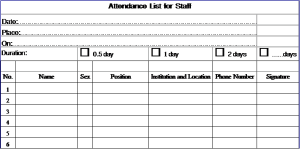
xxxx
Picture 1.2: Attendance List for TG-CD Event
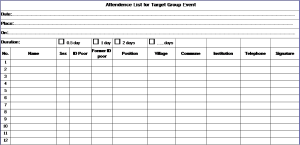
The HRD data for staff are enumerated in person-days for each person who has participated in a particular HRD event. The TG-CD data are enumerated as the number of participants as well as person-days per kind of target group which participated in an event. The data are disaggregated by gender, poverty (ID Poor) and vulnerability (Former ID poor) status as illustrated in pictures 2.1 and 2.2. Each event may be addressed to several target groups, for example the group of farmers, traders/collectors, village authorities, commune councils, district councils, etc.
Picture 2.1: Report on HRD for Staff Event
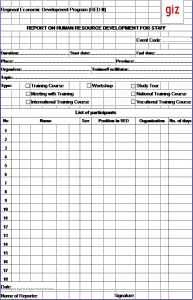
xxxxx
Picture 2.2: Report on TG CD Event

xxxxx
Data Entry
After summarizing the data from the attendance lists, the administrative staff inputs the data into an Excel data file. The HRD data for staff and the TG-CD data for target groups are entered in the same data file but into separate data sheets; this is done by component / province as shown in pictures 3.1 and 3.2.
xxxxx
Picture 3.1: Part of RED HRD for Staff Data File – Example for Siem Reap, Component 1A
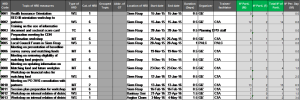
xxxxx
Picture 3.2: Part of RED TG CD Data File – Example for Oddar Meanchey, Component 2
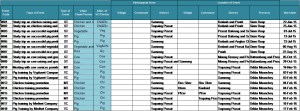
The administrative assistants also enter data from attendance lists and TG-CD summary reports into the beneficiary data files. This comprises data on individual participants (name, address, contact number, etc.) as well as the event (type of event, duration, location of event, etc.) as shown in picture 4.
xxxxx
Picture 4: Part of RED III Beneficiary Data File – Example for Banteay Meanchey, Component 2
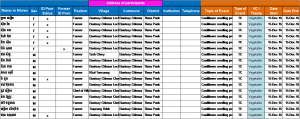
xxxxx
Data Processing and Reporting
From HRD and TG-CD data files, the RED M&E technical expert produces the respective summary reports on HRD measures for partner staff and TG-CD measures as illustrated in pictures 5.1 and 5.2. In addition, data of the beneficiary data files are also being processed for other reporting purposes.
xxxxx
Picture 5.1: RED III HRD for Staff Summary Report – Example Data for January – December 2016

xxxxx
xxxxxxxxxxxxxxxxxxxxxxxxxxxxxxxxxxxxxxxxxxxxxxxxxxxxxxxxxxx xxxxxxxxxxxxxxxxxxxxxxxxxxxxxxxxxxx
Picture 5.2: RED III TG CD Summary Report – Example Data for January – December 2016

So far, the beneficiary data files have been indispensable as:
- They allow the program to know the outreach in terms of persons (avoiding double counting when a person joined two or more events) and households. Individual and household outreach can easily be documented at any required level: project activity, village, commune and district level. This is also used for the visualization of activities on maps as shown in picture 6.
- They allow the program to easily generate a list of outreach villages, communes and districts in order to capture facts and figures on spatial coverage of the program as shown in picture 7.
- They provide a basis for discussion with local authorities (that can be at commune and district level) about areas that are so far under-served or under-represented in events organized by the program.
- They provide a basis for random selection of beneficiaries for evaluation studies.
- As a small side benefit: they are the source of contact numbers of particular individuals since phone numbers are recorded.
xxxxx
Picture 6: Map of agricultural training activities – Example for Banteay Meanchey
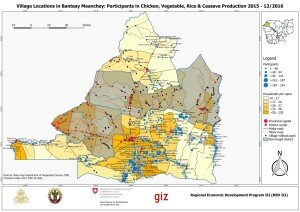
xxxxx
Picture 7: Part of RED III Monitoring Outreach – Example from Banteay Meanchey
 All processed and visualized data (HRD & TG-CD data, maps, facts, figures) plus the data from occasional impact assessment surveys are the basis for mid-year and annual reports.
All processed and visualized data (HRD & TG-CD data, maps, facts, figures) plus the data from occasional impact assessment surveys are the basis for mid-year and annual reports.
xxxxx
Conclusion
The RED III data management is a relatively resource-intensive, but conceptually simple and robust process. In terms of software, it mainly needs the Microsoft Office Program Excel and for map visualization a public domain GIS such as Q-GIS. It requires data collection, entering and validating data as well as reporting in a systemic manner. Technically, all people involved in the process are to be familiarized with the formats and file structures which is a task for the project’s M&E expert who needs to have advanced knowledge in Excel, data and map processing. One of the major advantages of applying Excel for managing the data is that it has flexible tools for visualization to which data sets can easily be customized and reports generated.
For further information, please contact:
Dr Wolfram Jaeckel, RED III Program Leader | , Or
Mr Samrach Ten, RED III Planning, Monitoring and Evaluation Advisor |

